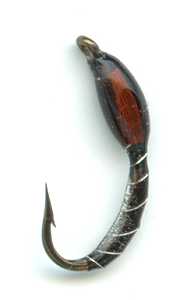Black Ribbed Epoxy Buzzer Midge Nymph
So how do you fly fish for rainbow trout on open water on a bright sunny day? Many opt for streamers but my choice is the standard black silver ribbed epoxy buzzer. They can out-fish all streamers if fished correctly.

EPOXY BUZZER MIDGE FLY PATTERNS. Hook size 14 12 - $US each
Most still waters have large hatches of tiny chironomids that are more commonly known as buzzers. They form the basis of most trout’s diets all year around. Some small still waters only allow one nymph on the line. In these cases you need to make each take count. Using a bite indicator helps you observe each nibble, but you can still miss a lot of trout if you are not quick enough. Bite indicators are also a good way to control the depth you are fishing. All you do is just slide it up and down the leader until you find the correct depth that the fish are feeding. If nothing is taking your fly then it is time to experiment. Change the depth until you find them. Look out for signs of a hatch starting and get your fly under the water in that location. If there are flies hatching on the surface there are a lot more nymphs about to rise under them. Watch for moving fish and increased activity in insect feeding birds like summer swallows. They are good indictors to idea locations to cast your flies.
Most anglers do not have the patients to fish a static fly but it can be more productive. You must resist the temptation to retrieve it. The only time you should move your line is to straighten it up. This can tempt a take because it causes the buzzer nymph to rise just like the real thing. When you have decided to retrieve the line pay attention. In clear water you may be able to see a trout following your buzzer towards the end of the retrieve. I you suddenly increase the rate of retrieve you may entice a take.
When river fishing for trout with teams of buzzers nymph fly patterns on the end of my rod I have had success inducing takes by directly raising the buzzer by simply lifting the fishing rod tip. This imparts a natural movement in the artificial as if it gave a small tweak then rested. This technique can be very effective at close range but at longer distance it has the reverse effect as it makes the nymph move un-naturally fast in the water flow. These buzzer nymphs are not fast swimmers. If your artificial fly suddenly develops superpowers it will scare off lurking trout.
What you can do is try to get closer to your prey by stalking along the river bank. Stay low, use natural trees, bushes and bankside vegetation to hide your approach. Do not wear bright clothing. If the water is not too deep wade closer slowly. This type of fishing requires extreme patience and stealth. Use a longer rod to improve your control over a greater distance.
Fishing difficult locations
Last September I went to a fishery In Hampshire. My fly fishing Scotland Yard Detective brother-law Richard invited me to join him. It was one of his favourite places as there was a limit of eight rods at one time. It was never over crowded.
As I have suggested before it is always a good thing to walk around the lake or river bank and spend time studying the water and local insect life before starting to fish. On our second lap of the lake Richard spotted a large fish lying in a deep hole under a tree on the far bank.
‘It's difficult to see it clearly in this light,’ Richard said to me,’ it is about eight feet down so I am going to tie on a weighted deepwater Viva Woolly Bugger fly to get down to it.’ With that Richard crouched down and using a catapult cast flicked his fly out, letting the fly drop down to the fish. There were a lot of overhanging branches so a normal cast would get caught up.
He had practiced and practiced with this unusual method of casting to enable him to land his fly on target 99% of the time. My success rate is still in the low 50% range. He holds onto the line near the hook, locks the line and then pulls back so the rod bows. When he lets go the fly shoots off towards the target zone. This does not work on a stiff rod.
I saw his line skim over the water surface under the branches. The fly landed on top of the fish’s location. The result was instantaneous. The fish took. Richard struck and an almighty commotion ensued on the surface. After a hectic scrap, Richard slid his net under a Rainbow trout of 7lb. it was a lovely looking fish but for one thing, its tail was damaged with the corners worn away.
I spotted three good looking rainbows cruising along the edge of a weed bed. I decided to have a go for them, opting for a small black epoxy midge buzzer with orange cheeks, tied to a 10ft 6lb leader. I watched the patrol route of the fish, waited until one of them approached and timed my cast so the buzzer sank to the same depth of the fish.
With minimum effort, the trout breezed over to the buzzer, opened its mouth and sucked it in. There was no reaction from the fish. In fact it took the fly as confidently as I’ve ever seen a trout take a fly. I struck and hooked an angry rainbow that charged through the heavy weed in an attempt to get away. Thankfully my gear stood firm and I soon brought a 5lb Rainbow trout to the bank.




Fly Fishing books

